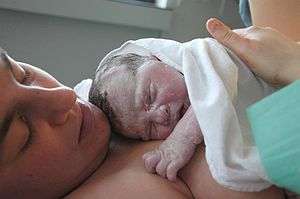Live birth (human)

In human reproduction, a live birth occurs when a fetus, whatever its gestational age, exits the maternal body and subsequently shows any sign of life, such as voluntary movement, heartbeat, or pulsation of the umbilical cord, for however brief a time and regardless of whether the umbilical cord or placenta are intact.[1]
This definition of the term "live birth" was created by the World Health Organization in 1950 and is chiefly used for public health and statistical purposes. Whether the birth is vaginal or by Caesarean section, and whether the neonate is ultimately viable, is not relevant to this statistical definition. However, the term "live birth" was in common use long before 1950.[2]
In the United States, the term "born alive" is defined by federal statute.[3] Some women have chosen to release online videos of the live births of their infants.[4][5][6] There is one case report of a woman having a live birth derived from a frozen embryo obtained before the woman began cancer treatment.[7]
See also
- Childbirth
- Perinatal death
- Stillbirth
- Intrapartum death
- Neonatal death
- Abortion
- Elective abortion
- Anomalous pregnancy
- Miscarriage
- Maternal death
- Born alive rule
References
- ↑ World Health Organization. International statistical classification of diseases and related health problems. Tenth Revision. Vol 2. Geneva, Switzerland: World Health Organization, 1993:129.
- ↑ Search full view Google Books for "live birth" prior to the year 1950.
- ↑ "1 U.S. Code § 8 - "Person", "human being", "child", and "individual" as including born-alive infant". LII / Legal Information Institute. Retrieved 22 August 2017.
- ↑ "This woman is livestreaming the birth of her child on Facebook". 9 February 2017. Retrieved 22 August 2017.
- ↑ Spangler, Todd (24 June 2016). "TLC Broadcasts Live Birth on Facebook". Retrieved 22 August 2017.
- ↑ Woolf, Nicky (17 May 2016). "The miracle of live: man uses Facebook Live to stream his child's birth". Retrieved 22 August 2017 – via The Guardian.
- ↑ Yang, Dunsong; Brown, Samuel E.; Nguyen, Kevin; Reddy, Vijay; Brubaker, Cindy; Winslow, Kevin L. (1 June 2007). "Live birth after the transfer of human embryos developed from cryopreserved oocytes harvested before cancer treatment". Fertility and Sterility. 87 (6): 1469.e1–4. doi:10.1016/j.fertnstert.2006.07.1546. PMID 17418837.
External links
- Fossil reveals oldest live birth BBC News 28 May 2008
